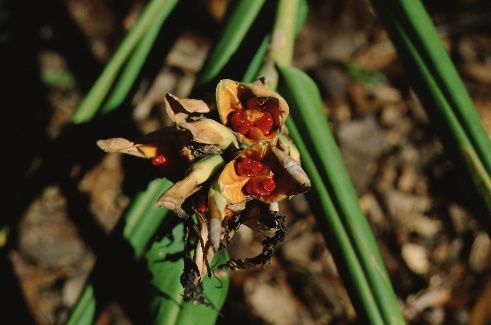Introduction
The butterfly ginger is one of the nicest gingers for the home landscape because its fragrance is so enjoyable. Pure white, showy flowers emerge from one large bud sometimes in late spring through summer at the tip of each unbranched stem. Each flower lasts about one day. Several hundred flowers can appear from each bud during a 6-week period. Each stem grows to about 5 feet tall. These herbaceous perennials spread by underground rhizomes, often forming dense clumps of multiple stems. Large, simple leaves are borne on either side of the thick green stems. Unfortunately, individual flowers do not last after they are cut from the plant.

Credit: Edward F. Gilman, UF/IFAS

Credit: Edward F. Gilman, UF/IFAS
General Information
Scientific name: Hedychium coronarium
Pronunciation: hee-DICK-ee-um kor-oh-NAIR-ee-um
Common name(s): butterfly ginger, white garland-lily, white gingerlily
Family: Zingiberaceae
Plant type: herbaceous
USDA hardiness zones: 8B through 11 (Figure 3)
Planting month for zone 8: year-round
Planting month for zone 9: year-round
Planting month for zone 10 and 11: year-round
Origin: native to temperate and tropical Asia
Invasive potential: not considered a problem species at this time and may be recommended by UF/IFAS faculty (reassess in 10 years)
Uses: border; mass planting; suitable for growing indoors
Availability: grown in small quantities by a small number of nurseries

Credit:
Description
Height: 4 to 5 feet
Spread: 4 to 6 feet
Plant habit: upright
Plant density: open
Growth rate: fast
Texture: coarse
Foliage
Leaf arrangement: alternate
Leaf type: simple
Leaf margin: undulate
Leaf shape: lanceolate; oblong
Leaf venation: pinnate
Leaf type and persistence: deciduous
Leaf blade length: 8 to 12 inches
Leaf color: green
Fall color: no fall color change
Fall characteristic: not showy
Flower
Flower color: white
Flower characteristic: pleasant fragrance; summer flowering; fall flowering
Fruit
Fruit shape: unknown
Fruit length: unknown
Fruit cover: unknown
Fruit color: unknown
Fruit characteristic: inconspicuous and not showy
Trunk and Branches
Trunk/bark/branches: typically multi-trunked or clumping stems
Current year stem/twig color: green
Current year stem/twig thickness: very thick
Culture
Light requirement: plant grows in part shade/part sun
Soil tolerances: occasionally wet; acidic; slightly alkaline; sand; loam; clay
Drought tolerance: moderate
Soil salt tolerances: unknown
Plant spacing: 24 to 36 inches
Other
Roots: not applicable
Winter interest: no special winter interest
Outstanding plant: plant has outstanding ornamental features and could be planted more
Pest resistance: long-term health usually not affected by pests
Use and Management
Place butterfly ginger near a walk or window so the fragrance can be enjoyed. The foliage texture makes them nicely suited for creating an accent in a shrub border when it is not in flower.
Plants grown in full sun or partial shade flower best. Those in the shade often grow but few flower buds are produced. Rhizomes can be dug any time and divided for propagation.
Pests and Diseases
No pests or disease normally restrict use of this plant in Florida landscapes.